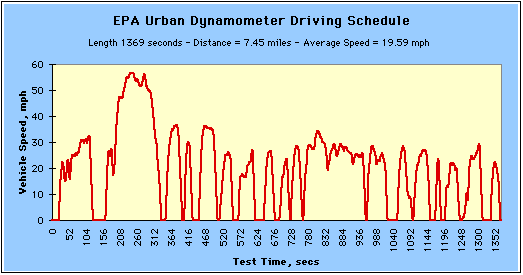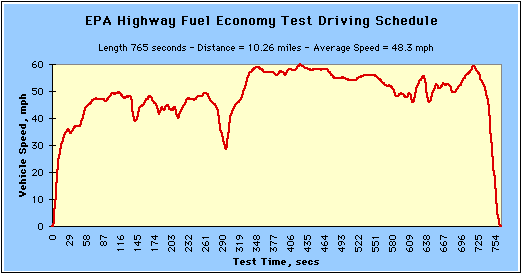Drivers Are Confused By Unrealistic EPA Range Figures
I was recently discussing the issue of EPA range with some friends online. After seeing Consumer Reports and others bash Tesla for not meeting EPA range targets in the real world, most agreed that the problem isn’t with Tesla as much as the EPA. Because both the city and highway driving tests are far less energy intensive than setting the cruise control at 70 MPH and driving a steady speed, people almost always find that their vehicle does not get the “advertised” range when they take their first EV road trip.
In this article, I want to discuss why this happens and some things the EPA and auto manufacturers can do to improve the situation.
EPA Test Cycles
When it comes to energy consumption and range, EV testing has a lot in common with gas vehicle testing. The “schedules” or “test cycles” a car has to go through are the same, and then figures derived from those are used to calculate the vehicle’s range.
Let’s start with the city cycle:

This kind of stop-and-go driving is hell for ICE vehicles because you spend a lot of time accelerating and sitting at a pretend traffic light getting zero MPG. This is why the city figure is almost always lower for ICE vehicles. Hybrids solve this problem by shutting off the gas engine during stops and recovering energy during deceleration to be used when taking off again. So, hybrids generally get the same MPG in the city as on the highway.
EVs excel at this test, though. Regenerative braking is usually stronger, and there’s no internal combustion engine that wastes away fuel making heat. So, EVs tend to get far better range in this test cycle compared to the highway test cycle.
But, there’s a big problem with the highway test cycle:

The maximum speed for the EPA highway test is just under 60 MPH, while the average speed is only 48.3 MPH. There are also some traffic slowdowns simulated in the test, but not heavy traffic. With the average speed under 50 MPH, the effects of aerodynamic drag and rolling resistance are a lot lower, giving every vehicle unrealistic range and/or MPG in this test. Some city highway driving will look a lot like this test, but people in any vehicle traveling at 70, 75, or 80 MPH (all legal speeds in many rural parts of the United States and even in some cities) will consume a lot more energy than this test uses.
The EPA partially solves this problem through weighting and an energy use adjustment factor. Basically, the city figure accounts for 55% of the combined figure, while the highway figure (with 30% energy use added for “aggressive driving” and HVAC use) accounts for 45%. This final energy use figure is extrapolated for the available energy in the pack to produce an EPA-rated range.
Vehicles Usually (But Not Always) Fall Short in 70 MPH Tests
Even with the EPA’s added energy usage on the highway portion, making 55% of the range figure come from city driving means that the final figure is overly optimistic. If you took road trips at 50 MPH and hypermiled the hills out, you might get pretty close or exceed the rated EPA range. But testing finds that most EVs can’t go nearly as far as the EPA rates them for.
There are some notable exceptions, though. The Porsche Taycan has been shown to beat the EPA-rated range by dozens of miles in car magazine and enthusiast testing, but it has a multi-speed rear transaxle that keeps EV motor speeds lower at highway speeds than most EVs. However, the EPA figure for that car was also abysmal, so beating it doesn’t make the vehicle some sort of range monster as much as it makes it a technical outlier that was probably optimized for real-world more than EPA tests.
How Manufacturers & the EPA Can Do Better
The fundamental problem is that no range testing figure can cover everybody’s uses of an EV. In other words, “One size fits all” really doesn’t.
So, instead of publishing an end-all be-all range figure that many people will be disappointed by (and hypermilers use for finger-wagging), manufacturers should publish a range of highway range figures in a table for drivers to figure out what fits their needs. The city figure is probably OK for nearly all drivers, but if drivers had data for 60, 65, 70, 75, 80, and 85 MPH range with ambient temperatures on the other axis, they could decide whether the car would fit their individual range needs.
Software also plays a vital role here.
For one, good trip planning software keeps drivers from making bad decisions in trip planning. Given an EPA range and Google Maps, a novice driver (like I used to be) might think they can get from one station to the next because the miles are less than the range. But, at normal highway speeds, it’s easy to fall a little short and even end up running out of range on the highway. Good software eliminates that guesswork and lets people see if they can actually make it.
But, this doesn’t help people who haven’t bought the car. So, manufacturers should consider putting trip planning software online with a simplified interface for people to plan hypothetical trips. I know Tesla does this, and anyone can use something like A Better Route Planner or Chargeway, but most marketing materials don’t encourage people to simulate some trips to see if they can make it. Simply adding a link to a “road trip simulator” in the marketing can help buyers make an informed buying decision.
Education for new buyers is also essential. If a new EV buyer gets some quick instruction on things that reduce range, like steep hills or cold weather, and gets some pointers on trip planning, they’ll be far less likely to get the information wrong and have a terrible EV experience that makes them want to move back to ICE vehicles!
So, this isn’t a problem that can’t be solved. It doesn’t require an act of Congress or even convincing the EPA to do different test cycles. Simple changes to marketing, software, and education can solve the problem and keep people from being disappointed or feeling cheated.
Have a tip for CleanTechnica? Want to advertise? Want to suggest a guest for our CleanTech Talk podcast? Contact us here.
Latest CleanTechnica.TV Video

CleanTechnica uses affiliate links. See our policy here.

